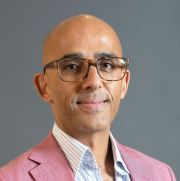This year’s Harvard Macy Institute Program for Educators in Health Professions included an optional field trip to the Museum of Fine Arts in Boston led by the faculty of the Art Museum-based Health Professions Education Fellowship. This is a retelling of my experience.
Walking up to the museum in the drizzle of rain, I wondered what had I gotten myself into? I should have switched to a different session, like I told my partner I was going to. During math teaching with my 12-year-old son, I am always nagging him to have a growth mindset and open his brain doors. I now know how he felt, my mindset was fixed, and I was clearly out of my element. The group all seemed very much more artistic than me.
The afternoon started with some breathing exercises. I love yoga but did not feel ready to do it here and now. The moment of my awakening happened as we sat in our group intently staring at a painting of a man standing next to a woman who was sitting. Our task was to describe what we saw as our instructor eloquently engaged us in a visual thinking strategies conversation. What is going on in this picture, what do you see that makes you say that, and what more can we find? These are the three main questions that lead to inquiry. Many spoke and described the emotions in their faces, the crack in the wall, the crown on the ground, the dark sky. I could not un-see a swollen hand, which no one else did. Was I naive, non-artistic, too ‘doctor-y’? Was I still thinking of a recent colleague’s microteaching session on glomerular diseases? I began to realize how even though we observe the same subject, our interpretation is guided by who we are, the shoes we walk in, and the stories we have experienced. I had never ever realized this, yet it seemed intuitive. Of course, our observations are guided by who we are as individuals, but this was a moment where it felt truly authentic, truly real. As clinicians, we are observing our patients all day long. What judgements, bias, and past experiences impact this? I ask my learners to do the same and assume their observations are unbiased and pure. Have we walked in each other’s shoes enough to be true to these assumptions?
What have I learned from this? Firstly, I know very little about visual thinking strategies. I realize now that individualized observation impacts so much of what we do as clinicians, educators, care givers. How can we accept this bias, this judgement, and allow it to guide us and make us better instead of hiding it and pushing it away. Sharing this, acknowledging that it is a part of us, and a part of who we are as people. Writing a story, putting emotions into words makes it real, important. Maybe even more concrete? In our closing large group plenary focused on using the science of narrative identity to integrate our Harvard Macy Institute experience, course faculty Jonathan Adler spoke to us about sensations and perceptions. Is this all I am experiencing? Am I just perceiving a sense? Is interpretation the same as perception? Is judgment the same as interpretation? Is bias the same as judgment? I believe that when we sense something, our bias, judgment, and interpretation all play a role in how we perceive that sense.
Observations are so much more than just colors, numbers, textures. They can be emotional, vulnerable, uncomfortable. It is up to us what we do with them, can we allow ourselves to acknowledge and honor each of them to help us see and feel, authentically? Art has awakened a part of me that I never knew existed. In his Harvard Macy Community Blog post, Anson Koshy described how visual thinking strategy is like “A moment of seeing, when something unsaid is simply waiting for you to take notice.” This awakening now allows me to look deeper for those moments of what is unsaid not only in education and the clinical environment but in everyday life. The Truth and Reconciliation Commission of Canada has highlighted the many wrongdoings which have been experienced among Indigenous peoples. I believe that art museum-based techniques like visual thinking strategies allow us to see, hear and feel these wrongdoings as we search for reconciliation. My short experience at the Museum of Fine Arts on a rainy afternoon in Boston opened a box of questions and curiosity. I am sure it can move the needle in all of us, just a bit, if we let it.
Did you know that the Harvard Macy Institute Community Blog has had more than 400 posts? Previous blog posts have explored topics including the art of education, art as antidote, and can art reframe medicine?
Rahul Mainra


